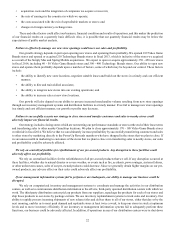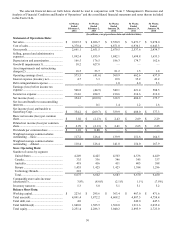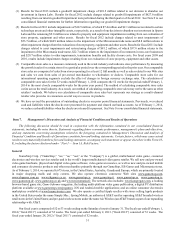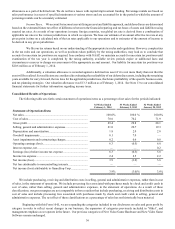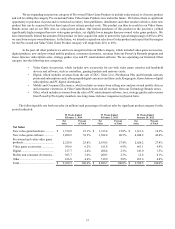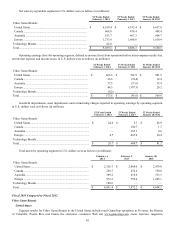GameStop 2013 Annual Report Download - page 49
Download and view the complete annual report
Please find page 49 of the 2013 GameStop annual report below. You can navigate through the pages in the report by either clicking on the pages listed below, or by using the keyword search tool below to find specific information within the annual report.32
Growth in the electronic game industry is generally driven by the introduction of new technology. Gaming consoles are
typically launched in cycles as technological developments provide significant improvements in graphics, audio quality, game
play, Internet connectivity and other entertainment capabilities beyond video gaming. The current generation of consoles (the Sony
PlayStation 4, the Microsoft Xbox One and the Nintendo Wii U) were introduced between November 2012 through November
2013. The previous generation of consoles (the Sony PlayStation 3, the Microsoft Xbox 360 and the Nintendo Wii) were introduced
between 2005 and 2007. The Nintendo 3DS was introduced in March 2011, the Sony PlayStation Vita was introduced in February
2012 and the Nintendo 2DS was introduced in October 2013. Typically, following the introduction of new video game platforms,
sales of new video game hardware increase as a percentage of total sales in the first full year following introduction. As video
game platforms mature, the sales mix attributable to complementary video game software and accessories, which generate higher
gross margins, generally increases in the subsequent years. The net effect is generally a decline in gross margin percent in the first
full year following new platform releases and an increase in gross margin percent in the years subsequent to the first full year
following the launch period. The launch of the next-generation Sony PlayStation 4 and the Microsoft Xbox One should negatively
impact our overall gross margin percentage in future years. Unit sales of maturing video game platforms are typically also driven
by manufacturer-funded retail price reductions, further driving sales of related software and accessories. Historically, new hardware
consoles are typically introduced every four to five years. We experienced declines in new hardware and software sales throughout
the first few months of fiscal 2013 due to the age of the older generation of consoles. With the introduction of the new consoles
in the fourth quarter, sales of new hardware have increased.
We expect that future growth in the electronic game industry will also be driven by the sale of video games delivered in
digital form and the expansion of other forms of gaming. We currently sell various types of products that relate to the digital
category, including digitally downloadable content ("DLC"), Xbox LIVE, PlayStation Plus and Nintendo network points cards,
as well as prepaid digital and online timecards. We expect our sales of digital products to increase in fiscal 2014. We have made
significant investments in e-commerce and in-store and Web site functionality to enable our customers to access digital content
easily and facilitate the digital sales and delivery process. We plan to continue to invest in these types of processes and channels
to grow our digital sales base and enhance our market leadership position in the electronic game industry and in the digital
aggregation and distribution category. In fiscal 2011, we also launched our mobile business and began selling an assortment of
tablets and accessories. We currently sell tablets and accessories in all of our stores in the United States and in a majority of stores
in our international markets. We also sell and accept trades of pre-owned mobile devices in our stores. In addition, we intend to
continue to invest in customer loyalty programs designed to attract and retain customers.
In November 2013, we acquired Spring Mobile, an authorized AT&T reseller operating over 160 stores selling wireless
services and products, and acquired Simply Mac, an authorized Apple reseller selling Apple products and services in 23 stores.
We also opened 31 stores under the Aio Wireless brand. Aio Wireless is an AT&T brand selling pre-paid wireless services and
products. We expect to expand the number of Spring Mobile and Simply Mac stores which we operate in future years. We also
expect to expand our pre-paid stores with AT&T under either the Aio Wireless brand or the Cricket brand following AT&T’s
acquisition of Leap Wireless.
Critical Accounting Policies and Use of Estimates
The preparation of financial statements in conformity with accounting principles generally accepted in the United States of
America (“GAAP”) requires us to make estimates and assumptions that affect the reported amounts of assets and liabilities, the
disclosure of contingent assets and liabilities at the date of the financial statements and the reported amounts of revenues and
expenses during the reporting period. In preparing these financial statements, we have made our best estimates and judgments of
certain amounts included in the financial statements, giving due consideration to materiality. Changes in the estimates and
assumptions used by us could have a significant impact on our financial results, and actual results could differ from those estimates.
Our senior management has discussed the development and selection of these critical accounting policies, as well as the significant
accounting policies disclosed in Note 1 to our consolidated financial statements, with the Audit Committee of our Board of Directors.
We believe the following accounting policies are the most critical to aid in fully understanding and evaluating our reporting of
transactions and events, and the estimates these policies involve require our most difficult, subjective or complex judgments.
Revenue Recognition. Revenue from the sales of our products is recognized at the time of sale, net of sales discounts
and net of an estimated sales return reserve, based on historical return rates, with a corresponding reduction in cost of sales. Our
sales return policy is generally limited to less than 30 days and as such our sales returns are, and have historically been, immaterial.
The sales of pre-owned video game products are recorded at the retail price charged to the customer. Advertising revenues for
Game Informer are recorded upon release of magazines for sale to consumers. Subscription revenues for our PowerUp Rewards
loyalty program and magazines are recognized on a straight-line basis over the subscription period. Revenue from the sales of
product replacement plans is recognized on a straight-line basis over the coverage period. Gift cards sold to customers are recognized


